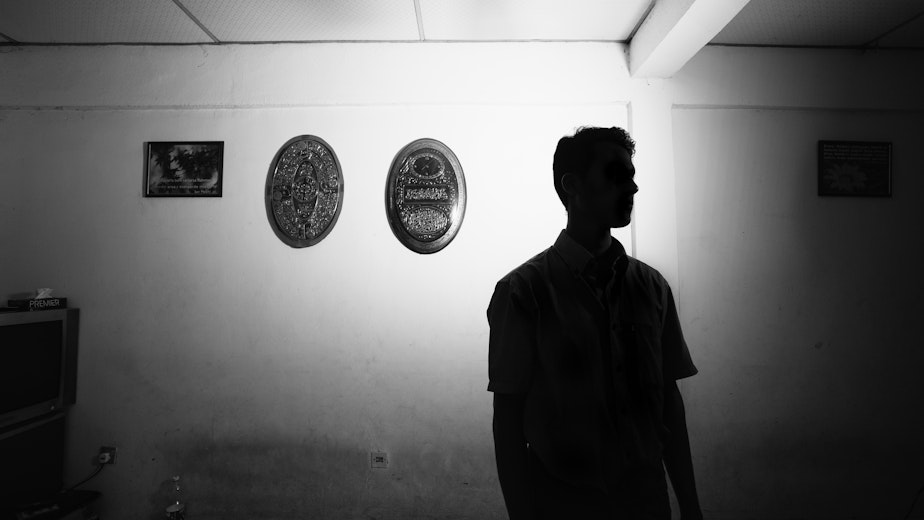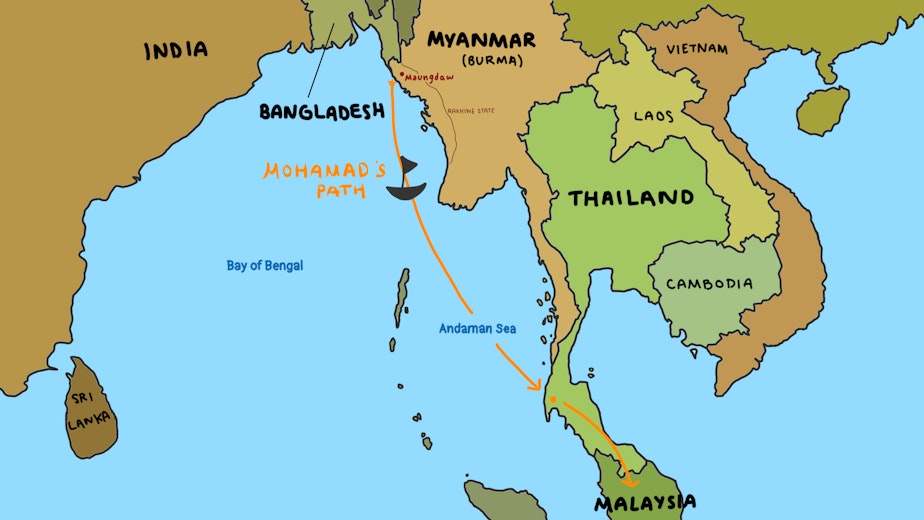A Rohingya teen escaped genocide in Myanmar. This is how he ended up on Mercer Island.

The Rohingya are a Sunni Muslim ethnic minority in Myanmar. In 1982, the government of Myanmar revoked the Rohingya people's citizenship.
Over the last decade, the government has escalated its campaign to push the Rohingya people out. People like Mohamad Imran, a 17-year-old in my class at Mercer Island High School.
Mohamad told me about the violence and discrimination his family faced in Myanmar — and the story of his long journey to the United States.
"The military killed people, and we were not able to go to school," Mohamad said. "They closed the market. We were not able to go shopping. They threw the bomb in the shopping mall. It was really dangerous to live there."
Because Mohamad's family was Rohingya, the Burmese government didn't give them permission to build a permanent wooden house on the ground.
"We built a house with bamboo in a tree because we were not able to build a big house and use strong wood," he said.
When Mohamad was 13, his family made plans to get him to safety. Mohamad's father found someone to smuggle Mohamad out via boat.
The smuggler promised Mohamad's family that his journey would last seven days and be taken under the best conditions. That was a lie.
For one thing, the trip took five months instead of seven days. Mohamad said that there wasn't any food on the boat, and it was hard to sleep because of the cold and lack of space.
"After five days, people became mental," he said. "People were crazy."
There were more than 100 refugees crammed onto the rickety boat. Even though Mohamad was one of them, he still felt completely alone and exhausted.
"I missed my family," he said. "I missed my friends. I missed my village because I was born there, and I felt like I lost everything."

When Mohamad finally stepped off the boat, he was on the beaches of Thailand. He spent a few weeks staying in camps and trudging through the jungle until he found himself in Malaysia: long-haired, raggedly-clothed, unable to understand anyone around him, and hungry.
He went to where the food was. From morning to evening, Mohamad sat in a restaurant. The manager didn't know how to help Mohamad, so he called the police. Mohamad was taken to jail.
"They gave me a little bit of rice and one fish a day," he said. "But it was so bad. They beat people sometimes."
Three months into his stay in the jail, an interpreter from the United Nations came to speak with Mohamad.
Mohamad told the agent about fleeing for his life and escaping political violence. But the process to release Mohamad would take anywhere from six to twelve months, which meant that Mohamad had to remain in jail.
"I felt like, 'Oh my god, I'll be killed by myself.' It was so hard to see people fight each other and immigration [police] beat people. I was escaping the genocide in Burma, and I missed my family."
In the year and three months that he spent in jail, Mohamad was locked up with refugees from all over the world. He learned to sing Bollywood songs in Hindi, and he can speak Rohingya, Bengali, Hindi, Burmese, Malay, Thai, and English.
He was 14 when he was finally released. But where would he go next?
Mohamad didn't have a permanent place to stay in Malaysia. But at least he finally got a chance to call his family.
That's when he found out that his family thought he had died. They even had a funeral for him.
Mohamad's father connected him with a friend in Malaysia that Mohamad could stay with. Soon Mohamad was granted official refugee status to come to the United States. But that meant 10 more meetings over the course of four months.
For each of those meetings, Mohamad had to travel 16 hours on a bus.
Each time he arrived, countless background checks, medical exams, and interviews waited for him. In October 2016, Mohamad was granted admittance into the United States. He was 15 years old.
Two weeks later, Mohamad boarded a plane to Seattle. That's where he met his foster mom. Someone who he would live with, protected.
Now, Mohamad is safe. But back home in Myanmar, things have gotten worse for the Rohingya.
The BBC reported from Mohamad's village in the fall of 2017 that more than half a million Rohingya Muslims have fled to Bangladesh. Fifteen thousand refugees were left stranded with little food and water.

Mohamad's parents and four siblings are part of that half million Rohingya who are fleeing now. They are in a refugee camp in Bangladesh and still live in fear, but hopefully not for much longer.
Mohamad is working and saving his earnings to pay for their journey to Washington. His drive to help his family and the Rohingya people comes from the unbreakable tie he has with his home.
"I still like Myanmar," he said. "Because we were born there. This is our land, our motherland. We'll never forget this land."
Mohamad was brought to Washington State through the program Refugees Northwest of the Lutheran Community Services Northwest. The program, started in 1980, was created to "protect young refugees, immigrants, and trafficked youth who are alone and without caregivers." You can find out more on their website.
This story was created in KUOW's RadioActive Intro to Journalism Workshop for 15- to 18-year-olds at Jack Straw Cultural Center, with production support from Sonya Harris. Edited by Jeannie Yandel.
Find RadioActive on Facebook, Twitter and Instagram, and on the RadioActive podcast.



